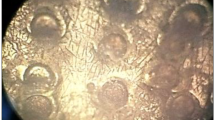Abstract
Nickel is widely used as a bleaching element in white gold alloys, but it is a potential allergen. In this paper, a popular 18 KW gold alloy, often called “safe nickel,” was chosen as the experimental material; its nickel release rates under six different processing conditions were evaluated according to the EN1811 standard. The results reveal that both the surface processing method and heat treatment technology significantly affect the nickel release rate. A coarse surface releases more nickel ions than a smooth surface. The sample normalized at 700 °C in the single region has a lower nickel release rate than the one treated at 550 °C in the two-phase phase region, while high temperature normalizing at 800 °C will accelerate it. All the measured nickel release rates of the experimental material under various processing conditions exceed the permitted threshold value in the Nickel Directive, which indicates that there exists the potential risk of nickel-induced allergy when it is used to make jewelries, especially for piercing types.
Graphical abstract
The surface topography of W4 sample after soaking in artificial sweat for one week, there are a large number of corrosion pits on the surface, which shows that the material under sand blasting is subjected to serious corrosion, and the nickel release rate will be accelerated.






Similar content being viewed by others
References
Henderson S. White gold alloys: colour measurement and grading. Gold Bull. 2005;38(2):55.
Poliero M. White gold alloys for investment casting. Gold Bull. 2001;31(2):10.
Darlenski R, Kazandjieva J, Pramatarov K. The many faces of nickel allergy. Int J Dermatol. 2012;51(5):523.
Miao WD, Mi XJ, Xu GD, Li HC. Effect of surface preparation on corrosion properties and nickel release of a NiTi alloy. Rare Met. 2006;25(6):243.
Lidén C, Norberg K. Nickel on the Swedish market. Follow-up after implementation of the nickel directive. Contact Dermat. 2005;52(1):29.
Yin R, Huang XY, Zhou XF, Hao F. A retrospective study of patch tests in Chongqing, China from 2004 to 2009. Contact Dermat. 2011;65(1):28.
Jacob SE, Moennich JN, McKean BA, Zirwas MJ, Taylor JS. Nickel allergy in the United States: a public health issue in need of a ‘‘nickel directive’’. J Am Acad Dermatol. 2009;60(6):1067.
Nonaka H, Nakada T, Ijima M, Maibach HI. Metal patch test results from 1990–2009. J Dermatol. 2011;38(3):267.
European Communities. European Directive 94/27/EC of 30 June 1994 amending for the 12th time Directive 76/769/EEC on the approximation of the laws, regulations and administrative provisions of the Member States relating to restrictions on the marketing and use of dangerous substances. Off J Eur Commun. 1994;37:1.
The Commission of European Communities. Commission Directive 2004/96/EC of 27 September 2004 amending Council Directive 76/769/EEC as regards restrictions on the marketing and use of nickel for piercing post assemblies for the purpose of adapting its Annex I to technical progress. Off J Eur Union. 2004;301:51.
Yan ZW, Meng HM. Effect of heat treatment of titanium substrates on the properties of IrO2-Ta2O5 coated anodes. Rare Met. 2011;30(5):439–446.
McDonald A, Sistare G. The metallurgy of some carat gold jewellery alloys. Gold Bull. 1978;11(4):128.
Azar V, Hashemi B, Yazdi MR. The effect of shot peening on fatigue and corrosion behavior of 316L stainless steel in Ringer’s solution. Surf Coat Technol. 2010;204(21–22):3546.
Williams DE, Kilburn MR, Cliff J, Waterhouse GIN. Composition changes around sulphide inclusions in stainless steels, and implications for the initiation of pitting corrosion. Corros Sci. 2010;52(11):3702.
Yang SX, Liu ZP, Han SM, Zhang W, Song JZ. Effects of annealing treatment on the microstructure and electrochemical properties of low-Co hydrogen storage alloys containing Cu and Fe. Rare Met. 2011;30(5):464–469.
Laycock NJ, Newman RC. Localised dissolution kinetics, salt films and pitting potentials. Corros Sci. 1997;39(10–11):1771.
Raykhtsaum G, Agarwal DP. Nickel release tests—how well do they work? In: The Santa Fe symposium on jewelry manufacturing technology, New Mexico; 2001. p. 375.
Thyssen JP, Johansen JD, Menné T, Nielsen NH, Linneberg A. Nickel allergy in Danish women before and after nickel regulation. New Engl J Med. 2009;360(21):2259.
Biesterbos J, Yazar K, Lidén C. Nickel on the Swedish market: follow-up 10 years after entry into force of the EU Nickel Directive. Contact Dermat. 2010;63(6):333.
Thyssen JP, Uter W, McFadden J, Menné T, Spiewak R, Vigan M, Gimenez-Arnau A, Lidén C. The EU Nickel Directive revisited-future steps towards better protection against nickel allergy. Contact Dermat. 2011;64(3):121.
Schnuch A, Wolter J, Geier J, Uter W. Nickel allergy is still frequent in young German females—probably because of insufficient protection from nickel-releasing objects. Contact Dermat. 2011;64(3):142.
Acknowledgment
This project was financially supported by the united foundation of the National Natural Science Foundation of China and Guangdong province (No. U1034002).
Author information
Authors and Affiliations
Corresponding author
Rights and permissions
About this article
Cite this article
Yuan, JP., Li, W. & Liu, WM. Nickel release rate of 18 KW gold alloy for ornaments. Rare Met. 32, 33–39 (2013). https://doi.org/10.1007/s12598-013-0017-1
Received:
Revised:
Accepted:
Published:
Issue Date:
DOI: https://doi.org/10.1007/s12598-013-0017-1




